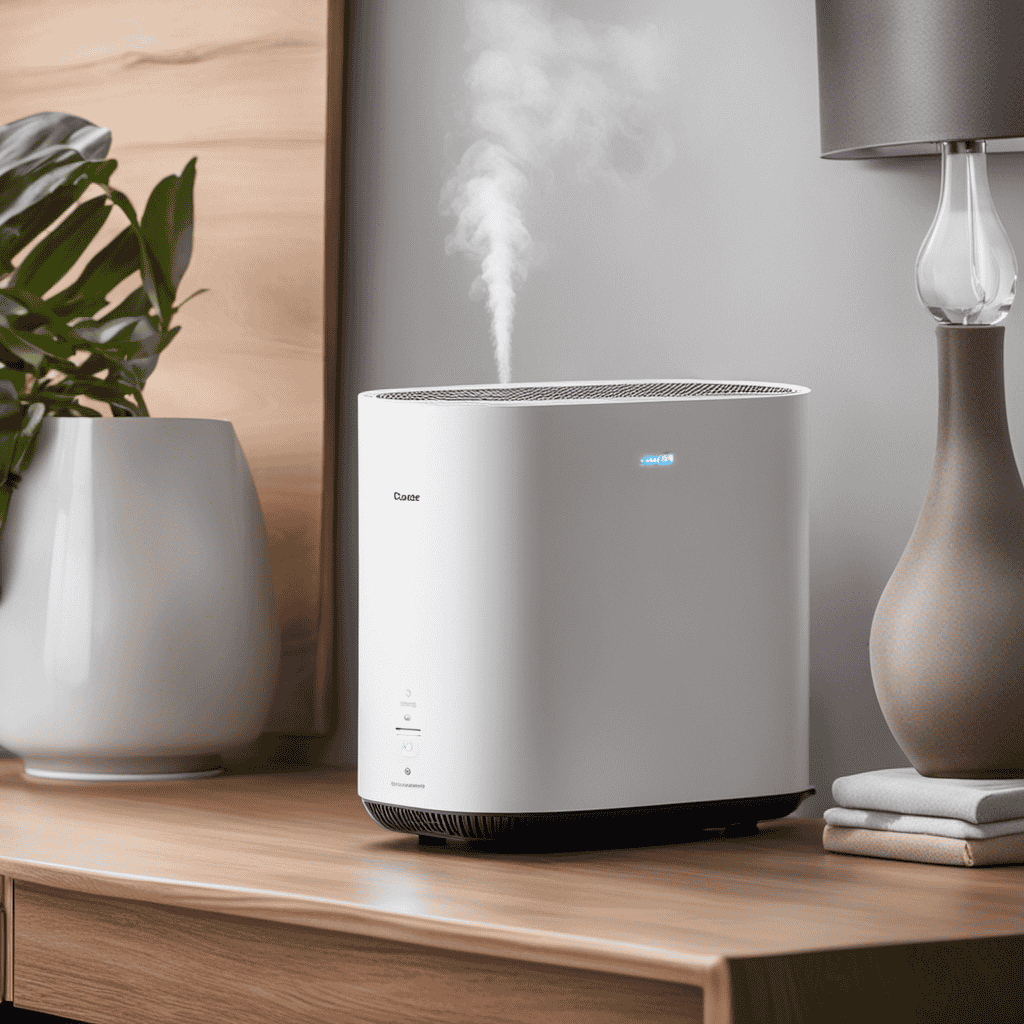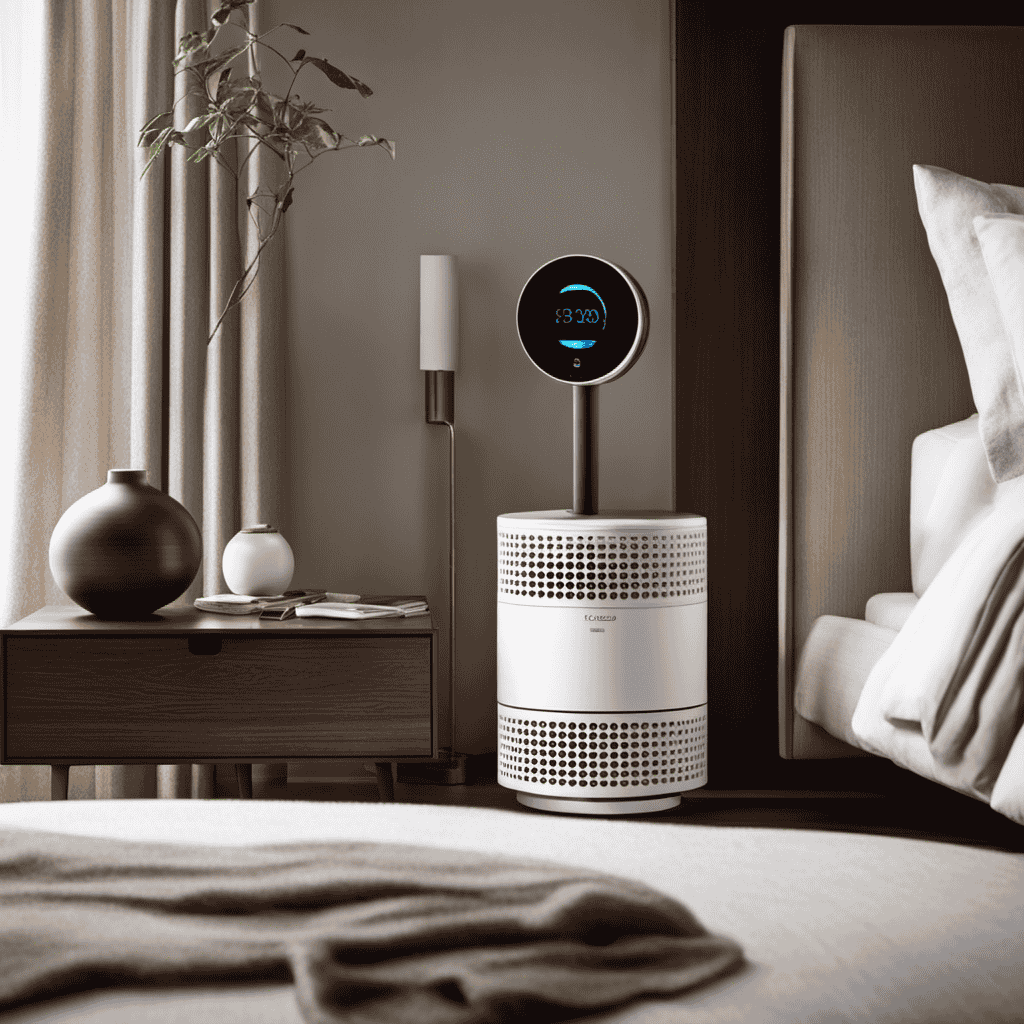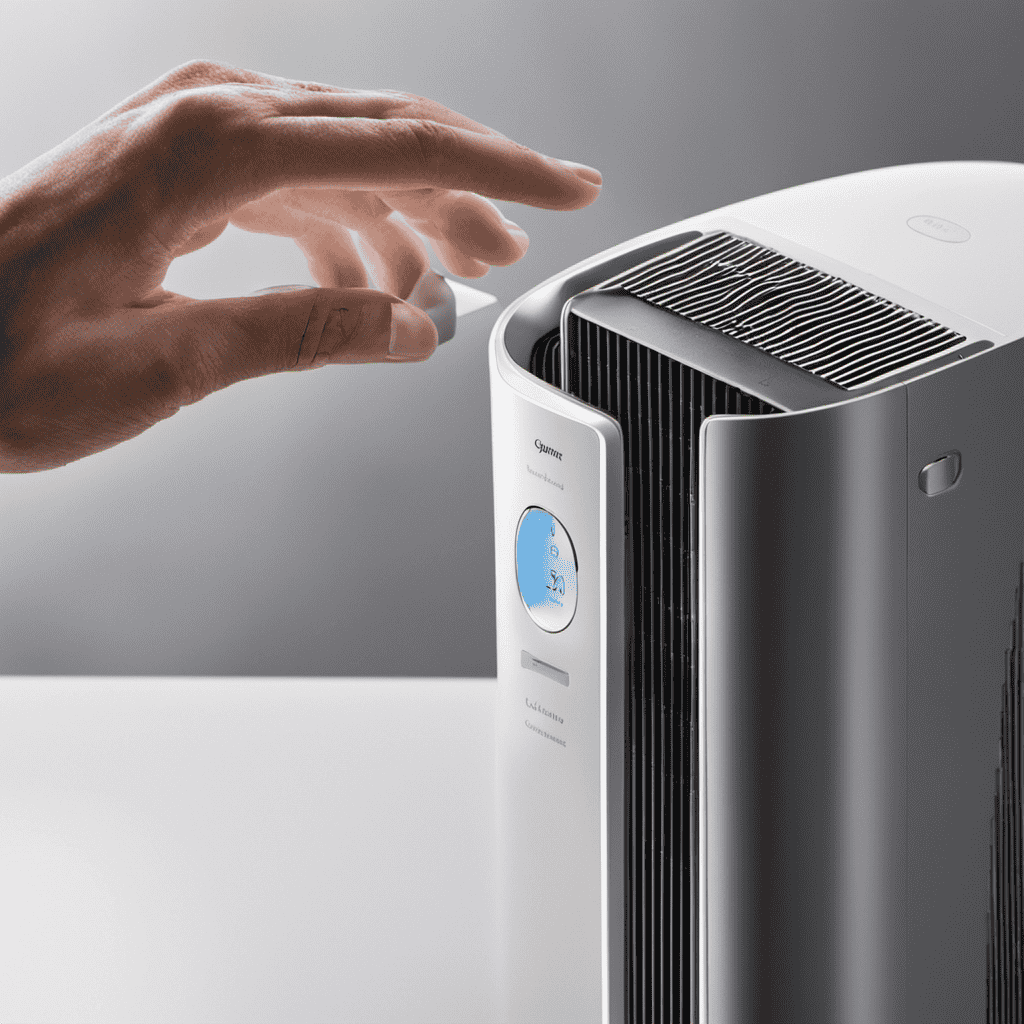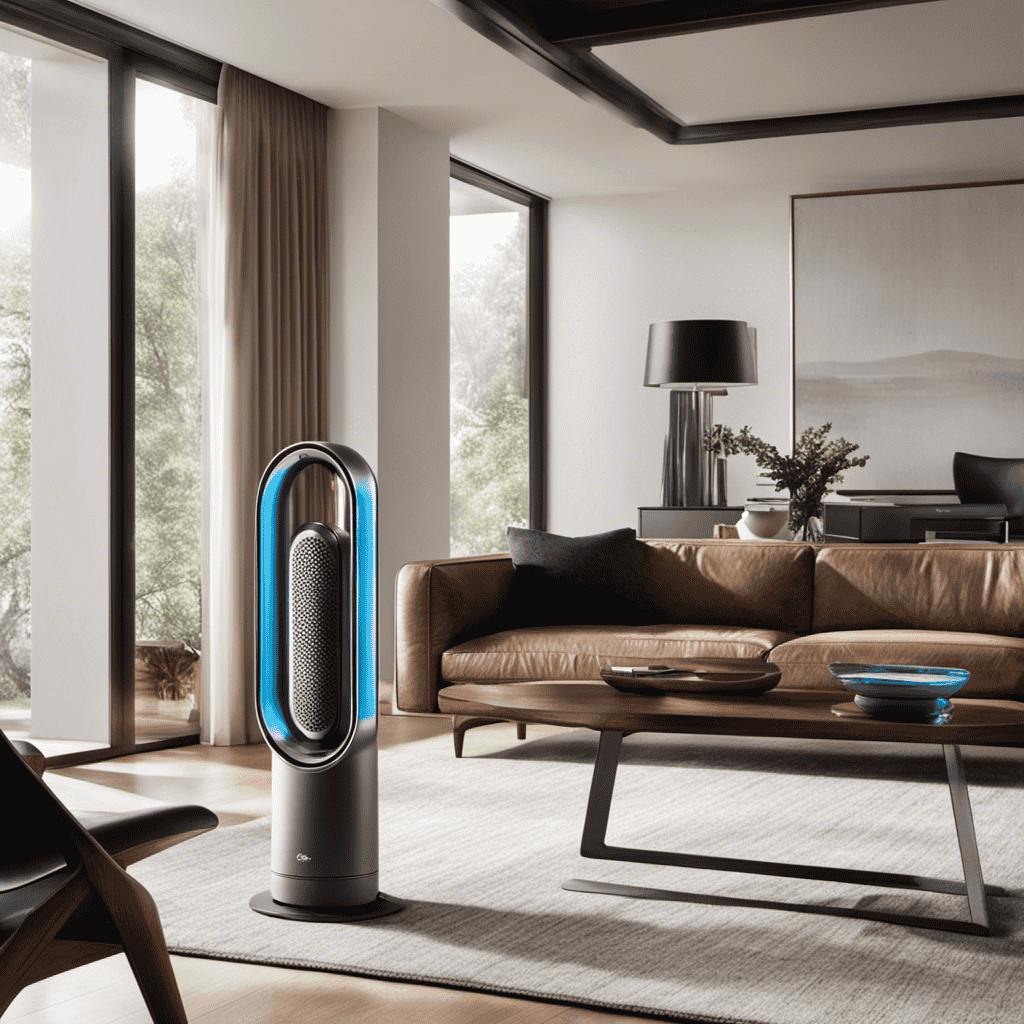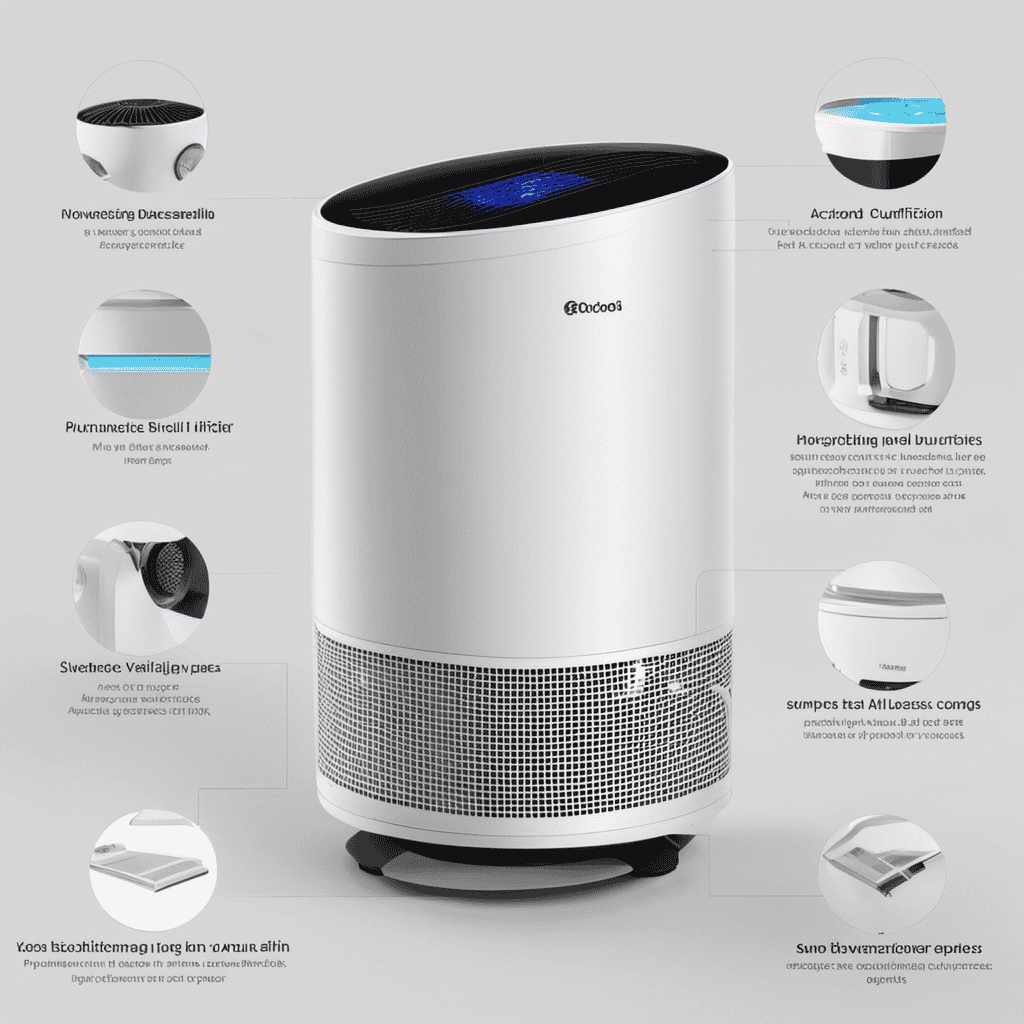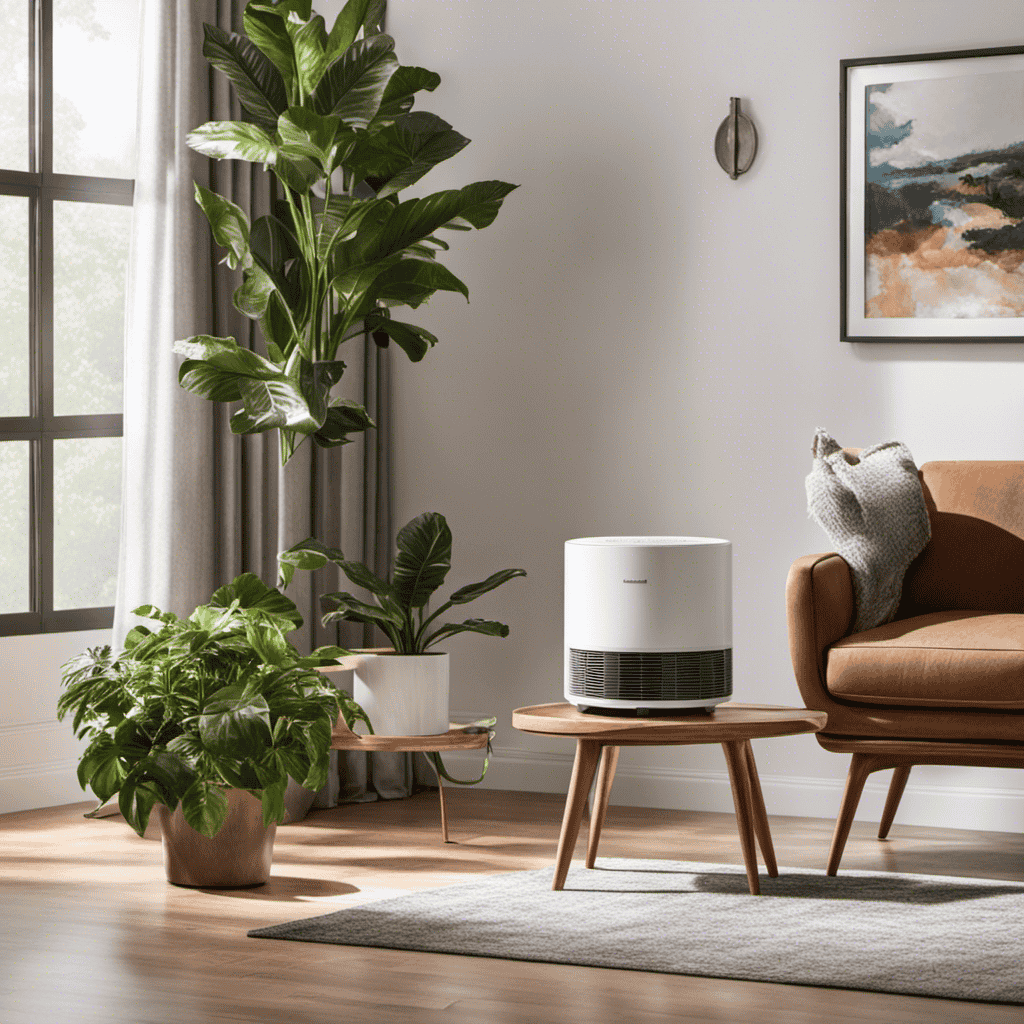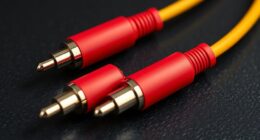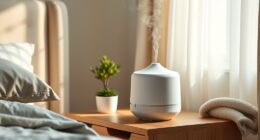Were you aware that the air inside can be as much as five times more contaminated than the air outside? This is precisely why grasping the distinctions between air humidifiers and purifiers is crucial.
In this article, I will explain the definitions and functionalities of both devices, as well as the key differences in moisture control and air filtration.
Additionally, I will discuss the health benefits of air purifiers and provide tips on how to choose between an air humidifier and purifier.
Finally, I will cover the maintenance and cleaning of these devices to ensure their effectiveness.
Key Takeaways
- An air humidifier adds moisture to the air, while an air purifier removes contaminants from the air.
- Air humidifiers are beneficial for people with dry skin, nasal congestion, or allergies, while air purifiers are effective in reducing airborne contaminants such as dust, pet dander, pollen, and mold spores.
- Air humidifiers help to prevent dry skin and ease respiratory discomfort caused by dry air, especially during winter months.
- Air purifiers remove pollutants and improve air quality, reducing the risk of allergies and respiratory issues, as well as eliminating unpleasant odors.
Definition of Air Humidifier and Purifier
An air humidifier adds moisture to the air, while an air purifier removes contaminants.
Air humidifiers are beneficial for people living in dry climates or those experiencing dry skin, nasal congestion, or allergies. They help alleviate these symptoms by increasing the humidity levels in the air, which can promote better breathing and relieve dryness.
On the other hand, air purifiers are effective in reducing airborne contaminants such as dust, pet dander, pollen, and mold spores. They use various filtration systems to capture and trap these particles, improving the overall air quality.
Both devices have their own advantages and should be chosen based on individual needs. It is important to consider the specific benefits of air humidifiers and the effectiveness of air purifiers when deciding which one to use in your home.
Functionality of Air Humidifier
I’ve found that using an air humidifier can greatly improve the quality of dry indoor air.
Not only does it help to humidify the air, but it also prevents dry skin and eases respiratory discomfort.
This is especially beneficial during the winter months when the air tends to be drier.
Humidifying Dry Indoor Air
To humidify your dry indoor air, you can use an air humidifier or a vaporizer. Both devices add moisture to the air, but they work in slightly different ways. An air humidifier releases a cool mist into the air, while a vaporizer produces steam. Both methods can be effective in preventing allergies and improving sleep quality by moisturizing the nasal passages and throat. Here is a comparison table to help you understand the differences between an air humidifier and a vaporizer:
| Air Humidifier | Vaporizer | |
|---|---|---|
| Method | Releases cool mist | Produces steam |
| Benefits | Prevents allergies, improves sleep | Prevents allergies, improves sleep |
| Maintenance | Regular cleaning required | Regular cleaning required |
| Cost | Varied | Varied |
| Noise Level | Generally quiet | Generally quiet |
Both air humidifiers and vaporizers provide similar benefits, so it ultimately comes down to personal preference and the specific needs of your indoor environment.
Preventing Dry Skin
Using a humidifier or vaporizer in my home can help prevent dry skin. Dry skin occurs when the air in my home lacks moisture, leading to discomfort and irritation. By increasing indoor humidity levels, I can keep my skin hydrated and healthy.
Additionally, maintaining proper indoor humidity levels can also prevent dry eyes, another common issue caused by dry air. Dry eyes can lead to itching, redness, and vision problems.
The benefits of proper indoor humidity extend beyond just preventing dry skin and eyes. It can also alleviate respiratory symptoms, such as congestion and coughing, and even improve sleep quality.
Overall, using a humidifier or vaporizer is an effective way to maintain optimal indoor humidity levels and promote healthy skin and eyes.
Easing Respiratory Discomfort
Maintaining proper indoor humidity levels can help alleviate respiratory discomfort caused by dry air. When the air in our homes becomes too dry, it can irritate our respiratory system, leading to symptoms such as coughing, congestion, and sore throat.
By using an air humidifier, we can add moisture to the air and provide relief from these discomforts. Research has shown that maintaining a humidity level between 40-60% can also help improve sleep quality. Dry air can cause nasal congestion and irritation, making it difficult to breathe properly at night. By increasing the humidity, we can reduce these symptoms and promote a more restful sleep.
In addition, proper humidity levels can also help alleviate allergies by reducing the amount of airborne allergens in the environment.
Functionality of Air Purifier
When it comes to improving indoor air quality, air purifiers are a popular solution.
In this discussion, we will explore the different air purification methods used by these devices and the benefits they offer.
Air Purification Methods
There’s a variety of air purification methods available on the market today. When it comes to comparing air purifiers and air conditioners, it’s important to understand their differences.
While both devices can improve indoor air quality, they serve different purposes. Air purifiers are specifically designed to remove pollutants and contaminants from the air, such as dust, pollen, pet dander, and mold spores.
On the other hand, air conditioners are primarily used to regulate temperature and humidity levels in a room or building. However, some air conditioners do have built-in air filtration systems that can help improve indoor air quality to some extent.
Ultimately, the importance of indoor air quality cannot be overstated, as poor air quality can lead to various health issues such as allergies, asthma, and respiratory problems. Therefore, investing in a good air purifier can be beneficial in maintaining a clean and healthy indoor environment.
Benefits of Air Purifiers
You can greatly benefit from using an air purifier in your home or office. Here are some reasons why:
-
Improved air quality: Air purifiers remove pollutants such as dust, pet dander, pollen, and mold spores from the air, reducing the risk of allergies and respiratory issues.
-
Odor elimination: Air purifiers can effectively eliminate unpleasant odors from cooking, pets, and smoke, leaving your space smelling fresh and clean.
-
Enhanced sleep quality: By removing airborne particles that can trigger allergies or disturb sleep, air purifiers can help improve sleep quality and promote a more restful night.
-
Comparison with air humidifiers: While air purifiers focus on removing impurities from the air, air humidifiers add moisture to the air. They serve different purposes but can be used together for optimal indoor air quality.
Investing in an air purifier can provide numerous benefits, ensuring that the air you breathe is clean and healthy.
Differences in Moisture Control
The air humidifier increases moisture levels, while the air purifier focuses on removing impurities from the air. Moisture control techniques play a vital role in maintaining indoor air quality. When the air indoors is too dry, it can lead to various issues such as dry skin, irritated eyes, and respiratory problems. An air humidifier helps to alleviate these problems by adding moisture to the air, making it more comfortable and reducing the risk of health issues.
On the other hand, an air purifier is designed to remove pollutants, allergens, and other impurities from the air, improving the overall air quality. By filtering out particles such as dust, pet dander, and pollen, it helps to reduce the risk of allergies and respiratory problems. While both devices contribute to a healthier indoor environment, they serve different purposes in terms of moisture control and air purification.
Now, let’s delve into the differences in air filtration.
Differences in Air Filtration
When it comes to air filtration, there are various methods that can be used to remove pollutants from the air. These methods include mechanical filtration, electrostatic precipitation, and activated carbon filtration.
Each method has its own effectiveness in removing different types of pollutants, such as dust, pollen, smoke, and odors. Understanding the different filtration methods and their effectiveness can help in choosing the right air filtration system for improving indoor air quality.
Filtration Methods Used
To understand the difference between an air humidifier and purifier, consider how they use different filtration methods.
When it comes to air humidifiers, their main function is to increase the moisture content in the air. They do this by releasing water vapor into the environment.
On the other hand, air purifiers focus on removing contaminants and pollutants from the air. They use advanced filtration technology to capture particles such as dust, pollen, and pet dander.
Here are three key points to consider:
-
Air humidifiers provide benefits like relieving dry skin, reducing static electricity, and soothing respiratory issues.
-
Air purifiers use various techniques like HEPA filters, activated carbon filters, and UV-C light to eliminate harmful particles and improve indoor air quality.
-
Both air humidifiers and purifiers can be beneficial in different situations, depending on your specific needs and concerns.
It’s important to understand these differences to choose the right device for your home or office.
Effectiveness in Removing Pollutants
If you want to improve the air quality in your home, you should consider the effectiveness of both devices in removing pollutants.
Air purifiers and humidifiers have different approaches when it comes to removing pollutants and improving indoor air quality.
Air purifiers are specifically designed to remove various pollutants such as dust, pollen, pet dander, and even harmful gases. They use filters and sometimes additional technologies like UV light or ionizers to capture and eliminate these pollutants from the air.
On the other hand, humidifiers primarily focus on adding moisture to the air to combat dryness. While they may not directly remove pollutants, maintaining proper humidity levels can indirectly improve indoor air quality by preventing the spread of airborne viruses and reducing the risk of respiratory problems.
Therefore, when it comes to differences in pollutant removal efficiency and impact on indoor air quality, air purifiers are more effective in removing pollutants directly, while humidifiers contribute to overall air quality by maintaining proper humidity levels.
Health Benefits of Air Humidifiers
The health benefits of air humidifiers include alleviating dry skin and reducing nasal congestion. Humidifiers increase the moisture in the air, which can be beneficial for our health in several ways:
-
Improved Skin Health: Dry air can cause skin to become dry, itchy, and flaky. By adding humidity to the air, humidifiers can help hydrate the skin and alleviate these symptoms.
-
Eased Respiratory Issues: Low humidity levels can lead to dry nasal passages and throat, which can worsen conditions like allergies, asthma, and sinusitis. Humidifiers can help moisturize the respiratory system, reducing congestion and making breathing easier.
-
Reduced Risk of Infections: Viruses and bacteria thrive in dry air, increasing the chances of respiratory infections. Proper humidity levels can help reduce the spread of these pathogens, lowering the risk of illnesses.
Health Benefits of Air Purifiers
You can improve the quality of your indoor air by using an air purifier, which helps to remove pollutants and allergens from your environment. Unlike a dehumidifier that primarily targets excess moisture in the air, an air purifier focuses on filtering out harmful particles. Let’s compare the benefits of an air purifier with those of a ventilation system:
| Air Purifier | Ventilation System |
|---|---|
| Removes pollutants and allergens from the air | Circulates fresh air throughout the space |
| Helps alleviate respiratory issues and allergies | Reduces stale air and odors |
| Can be used in specific rooms or areas | Provides overall air circulation in the building |
While both air purifiers and ventilation systems play important roles in maintaining indoor air quality, they serve different purposes. If you are looking to specifically target pollutants and allergens, an air purifier is more suitable. However, if you want to improve overall air circulation and freshness in your entire space, a ventilation system may be a better option. Now, let’s delve into how to choose between an air humidifier and purifier.
How to Choose Between an Air Humidifier and Purifier
When deciding which device to choose, consider the specific needs for air quality improvement in your space. Here are some factors to consider when choosing the right air purifier or air humidifier:
-
Size of the room: Choose an air purifier or humidifier that is suitable for the size of your room. A larger room may require a more powerful device.
-
Allergies and respiratory issues: If you suffer from allergies or respiratory problems, an air purifier with a HEPA filter can help remove allergens and pollutants from the air. An air humidifier can also provide relief by adding moisture to dry air.
-
Noise level: Some air purifiers or humidifiers can be noisy, so consider the noise level if you plan to use the device in your bedroom or office.
Choosing the right device depends on your specific needs and preferences.
Now, let’s discuss the maintenance and cleaning of air humidifiers.
Maintenance and Cleaning of Air Humidifiers
When it comes to air humidifier maintenance, there are a few key cleaning tips to keep in mind. Regular maintenance is essential to ensure that your air humidifier functions properly and provides clean and healthy air. Here are some important steps to follow:
| Cleaning Tips | Frequency |
|---|---|
| Empty and clean the water tank | Weekly |
| Replace or clean the filter | Monthly |
| Descale the humidifier if necessary | Every 3-6 months |
| Clean the exterior of the humidifier | As needed |
| Use distilled or demineralized water | Always |
Maintenance and Cleaning of Air Purifiers
To properly maintain and clean your air purifier, it’s important to follow a few key steps. Here are some cleaning techniques and the frequency of maintenance for your air purifier:
-
Regularly clean or replace the filters: The filters in your air purifier are responsible for trapping dust, allergens, and other particles. Cleaning or replacing them every 3 to 6 months ensures optimal performance.
-
Clean the exterior: Use a soft cloth or sponge dampened with mild detergent to wipe down the exterior of the air purifier. Avoid using abrasive cleaners that may damage the surface.
-
Check the vents: Regularly inspect the vents for any dust or debris buildup. Use a vacuum cleaner or a soft brush to remove any accumulated dirt.
Frequently Asked Questions
Can an Air Humidifier Also Purify the Air?
Yes, an air humidifier can also purify the air to some extent. While its main function is to add moisture, certain models may have additional features like filters or ionizers that help remove impurities and improve air quality.
Can an Air Purifier Also Add Moisture to the Air?
Can an air purifier also add moisture to the air? No, an air purifier’s main function is to remove pollutants and improve air quality. However, it is important to regularly maintain an air purifier to ensure its effectiveness and enjoy the benefits of clean air.
What Are the Potential Health Risks Associated With Using an Air Humidifier?
Potential health risks of using an air humidifier include increased mold and bacteria growth, respiratory issues, and allergies. However, there are also benefits such as relieving dry skin and reducing snoring. It’s important to weigh the drawbacks and benefits before using one.
Are There Any Specific Types of Air Pollutants That Air Purifiers Are More Effective at Removing?
Air purifiers are more effective than air humidifiers at removing specific types of air pollutants. They can target pollutants like dust, pollen, pet dander, and smoke, making them the best choice for improving indoor air quality.
Can Air Purifiers and Humidifiers Be Used in the Same Room at the Same Time?
Using both an air purifier and humidifier can create a more comfortable and healthier indoor environment. They serve different purposes, with the purifier removing pollutants and the humidifier adding moisture to the air.
Conclusion
In conclusion, choosing between an air humidifier and purifier depends on your specific needs and the air quality in your environment.
While both devices aim to improve air quality, they have distinct functionalities.
If you live in a dry climate or suffer from dry skin and respiratory issues, an air humidifier can help add moisture to the air.
On the other hand, if you are concerned about airborne pollutants, allergens, and odors, an air purifier with its filtration capabilities may be the better choice.
Ultimately, it is important to consider your personal requirements and the specific benefits each device offers to make an informed decision.
